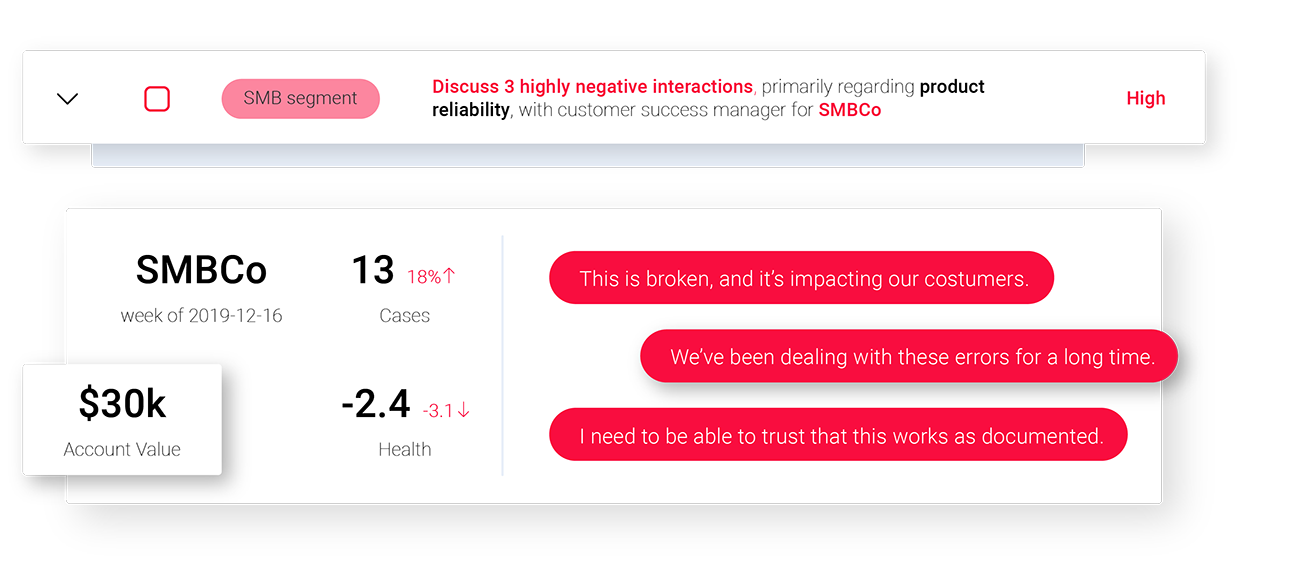#### With our voice-of-customer solution for CX leaders, anyone in your company can now understand what customers are talking about. It starts with a straightforward question: you need to know what your customers are talking about. Maybe it’s general topics and trends, or VIP priorities, or feature requests from a particular type of user. Whatever your question, what can you do **right now** to answer it? Leaders around a company typically have indirect ways of doing this:
- Review the most recent survey report. (And hope that it exists, is up to date, and covers the question you’re thinking about.)
- Read through random transcripts, looking for negative items and sending charged emails to subordinates
- Ask for a one-time analysis from your data team, then wait… indefinitely
- Book time with your users or send them a survey so you can ask them
#### The evolution of app analytics The business of understanding how people use your application has matured dramatically since the in-house MapReduce and Hadoop systems pioneered at Google, Yahoo, and Facebook in the 2000s. Years later, it’s now common to stack off-the-shelf technology together which collects behavioral data, normalizes it, feeds it to downstream systems, analyzes it, and generates reports. Every pageview, click, purchase, and misc. event can change a lead score, update a segment, initiate a workflow, and modify the customer experience. The spoils of these advancements have gone primarily to sales, marketing, and growth teams, which use browser data and profile enrichment to update content and workflows. I know this firsthand from years of glueing together products like Segment, Zapier, Heap, customer.io, Looker, and Appcues.
 Source: Segment’s Customer Data Infrastructure (CDI), aka my magic datapipeline
Source: Segment’s Customer Data Infrastructure (CDI), aka my magic datapipelineMore recently, some of this is trickling to customer success in the form of workflow tools like Gainsight, fusing Salesforce, product usage data, and process management. #### Have you noticed anythingmissing? How come getting answers for product and success requires an indirect research process (e.g., NPS and CSAT emails), while building reports and automation for sales, marketing, and growth feels like a video game? What about all the **actual conversations** your prospects and customers have with marketing, sales, support, success, and engineering _every day_ ? Most analytics systems can’t tell you much more than that the fact that they are happening. What if the substance of those conversations could be collected, enriched, summarized, and fed back to all the other teams that care about your customers? Answering any question starts with a simplesearch Frame AI is the missing hub for understanding customer conversations, enabling support and success teams to effortlessly present their impact, and allowing anyone whose job depends on what customers think to explore the data for themselves.
Answering any question starts with a simplesearch Frame AI is the missing hub for understanding customer conversations, enabling support and success teams to effortlessly present their impact, and allowing anyone whose job depends on what customers think to explore the data for themselves.
This entire data stack today is dedicated to making use of click data and sporadic surveys — ignoring the substance that composes some of the most valuable insights!#### We‘re changingthat.
 Answering any question starts with a simplesearch Frame AI is the missing hub for understanding customer conversations, enabling support and success teams to effortlessly present their impact, and allowing anyone whose job depends on what customers think to explore the data for themselves.
Answering any question starts with a simplesearch Frame AI is the missing hub for understanding customer conversations, enabling support and success teams to effortlessly present their impact, and allowing anyone whose job depends on what customers think to explore the data for themselves.- Collect chats and emails from every vendor and keep them in one place
- Unify data by contact, across systems and organizations
- Enrich previous exchanges with tags suggested by Frame
- View search results as tables of conversations or as dashboards populated by your query
- Share URLs with teammates, creating instant reports



